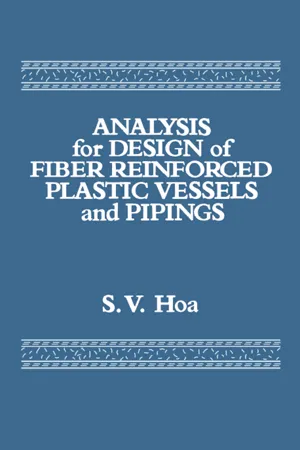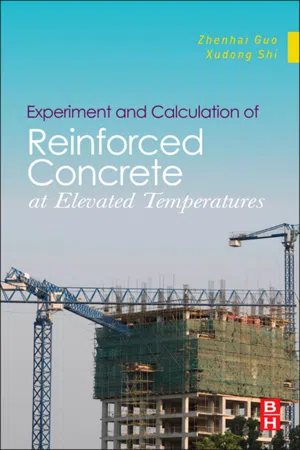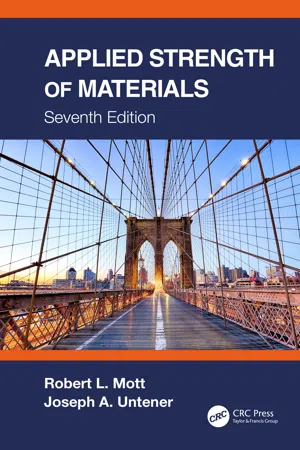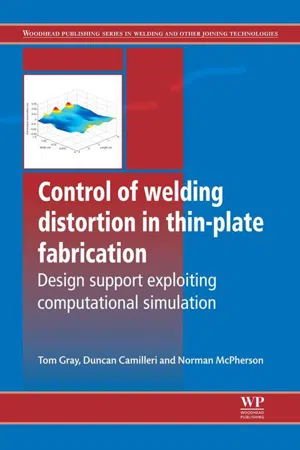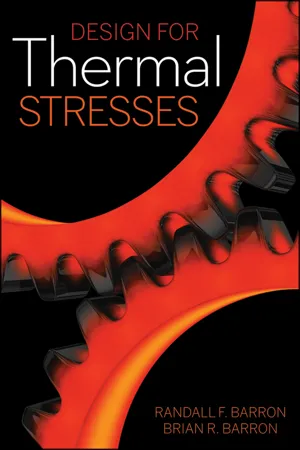Technology & Engineering
Thermal Strain
Thermal strain refers to the deformation or change in dimensions of a material due to changes in temperature. When a material is heated or cooled, its molecules expand or contract, causing the material to expand or contract as well. This can lead to stress and potential damage in materials and structures, making thermal strain an important consideration in engineering and design.
Written by Perlego with AI-assistance
Related key terms
Related key terms
1 of 4
Related key terms
1 of 3
6 Key excerpts on "Thermal Strain"
- Suong V. Hoa(Author)
- 2017(Publication Date)
- CRC Press(Publisher)
Just like any other material, composites deform when the temperature changes. In the linear theory, the resulting non mechanical strains are simply added to the mechanical strains induced by the stress to obtain the total strain. In the following discussion of thermoelastic constitutive relations, the temperature is assumed to be uniform throughout the material volume.Consider a composite layer in a reference state where temperature is To and σi = 0. Next the layer is brought into a final state where temperature T is different from To and σi ≠ 0. Figure 6.1 shows pictorially the two different states the layer is in.To determine the resulting strain we assume that the material is elastic, the response of the material does not depend on the history of the input but only on the initial and final states. Since the order of applications of the changes is immaterial, we conceptually imagine that the temperature is changed first, followed by the stress (see Figure 6.1 ). Let us denote the strain induced by the temperature change bye i T. The mechanical strain due to σj is given by Sij σj . It should be noted that since the stress is applied at temperature T, Sij (T) is the compliance measured under such condition. Thus, it may be significantly different from Sij (To ) which is measured at To . The final strain is the sum of the foregoing two types of strains:ε i=e i T+S ijσ j(6.25) 6.5. Thermal Residual Strains and Stresses Resulting from Thermal Change for General LaminatesAs the temperature changes, the resin deforms (shrinks or expands). The resulting deformation of a unidirectional composite in the transverse direction is much larger than in the longitudinal direction. Also the resulting individual deformations of each layer material are different from each other. Therefore, within the laminate, the deformation of one layer is constrained by the other layers with different fiber orientations or with different structural features, and hence thermal residual stresses are built up in each layer.- Zhenhai Guo, Xudong Shi(Authors)
- 2011(Publication Date)
- Butterworth-Heinemann(Publisher)
4-14), i.e., the strain of the reinforcement accelerates as the temperature increases continuously. The Thermal Strain is less when T ≤ 200 °C and increases quickly when T ≥ 300 °C, because the elastic modulus of the reinforcement at elevated temperatures decreases considerably and the creep appears unavoidably. The specimen at high stress level (σ/f y = 0.6) fails because its strain diverges when the ultimate temperature (Fig. 4-7) approaches. Figure 4-7 Ultimate temperature/tensile strength of reinforcement under the path of heating under constant load. [4-1] Figure 4-14 Thermal Strain of reinforcement under the action of stress [4-1] : (a) steel grade I; (b) steel grade II; (c) steel grade III; (d) steel grade IV; (e) steel grade V. The Thermal Strains of the reinforcements at the same temperature increase approximately linearly with the stress. The values of the Thermal Strains of grade I–IV reinforcements (mild steel) under the same conditions are similar, but that of grade V is obviously larger. Empirical formulas for Thermal Strain are given by Lu. [4-1] Compared with the freely expanding strain (Fig. 4-13), the Thermal Strain of reinforcement under the action of stress is less when the temperature T < 500–650 °C because the specimen is heated quickly without the constant temperature stages and the strain does not develop fully. However, the Thermal Strain is obviously larger when the temperature is even higher, because the elastic modulus decreases at elevated temperatures and the plastic strain increases quickly. The total strain of the reinforcement under the path of heating under constant load (σ – T) includes the load causing strain at normal temperature and the heating causing strain under constant stress. The total strain of the reinforcement under the path of loading at constant temperature (T – σ) includes the freely expanding strain and the load (stress) causing strain at elevated temperatures- Josip Brnic(Author)
- 2018(Publication Date)
- Wiley(Publisher)
In accordance with Equations (7.37), for a plane stress state we have: (7.38a) Solving Equations (7.38a) with respect to stress, it follows that: (7.38b) Figure 7.3 An orthotropic element in a plane stress state. 7.5 Linear Stress–Strain–Temperature Relations for Isotropic Materials In engineering practice there are different types of structural analysis. Structural analysis can be focused on the level of stress, strain, vibration, temperature, creep behavior, crack propagation, fatigue, service life assessment, and so on. In many cases, structural analysis refers to a static load or a dynamic load but often does not include temperature effects. However, stresses in a body can be caused not only by external loads but also by temperature increases (decreases). Temperature effects are of importance for any technological process, manufacturing process or any service life assessment for a structure. These effects are of importance when determining a material’s responses, since a material subjected to high temperatures can change its properties. Temperature effects can be considered in structures where one can expect fatigue problems, fatigue crack growth problems, creep problems, and so on. Fracture toughness and notch impact energy also depend on temperature effects. The influence of temperature on mechanical properties is clear from the engineering stress–strain diagrams presented in Chapter 4. Creep in metallic materials is considered in Chapter 9. In a structure subjected to cycle loading, in the presence of an elevated temperature, a smaller number of cycles to failure can be expected [8]. In addition, at temperatures above about half of the absolute melting temperature, nonlinear deformation may be expected due to time‐dependent phenomena (creep). In such a case, fatigue–creep interaction is also present. Higher temperatures give rise to a faster fatigue crack growth rate. As for fracture toughness, in general, it increases with an increase in temperature- eBook - ePub
- Robert L. Mott, Joseph A. Untener(Authors)
- 2021(Publication Date)
- CRC Press(Publisher)
14 Thermal Effects and Elements of More than One MaterialThe Big Picture14–1 Objectives of This Chapter14–2 Deformation due to Temperature Changes14–3 Thermal Stress14–4 Members Made of More than One MaterialThe Big Picture Discussion Map-
Engineering drawings typically represent parts in one given condition, but when the temperature changes, the material responds accordingly. In many applications, these changes must be considered for proper performance and safety.
-
Thermal changes when parts are free to grow or shrink without restriction will result in a change in part dimensions. If thermal changes occur while a part is restricted from growth or shrinkage, internal stresses will be induced.
-
Some elements that carry loads are made of more than one material. Those materials share the load, but not necessarily evenly. Analysis of each material is required to ensure proper performance and safety.
To this point, elements considered in this text have been assumed to remain at the same temperature. Automotive engine components like those shown in Figure 14-1 , though, can go through extreme temperature conditions. When sitting in the morning in a northern climate, the entire engine might be well below freezing. Within minutes of starting the engine, however, an internal component near the combustion of fuel will reach extremely high temperatures. As a designer, you must anticipate the full range of conditions and ensure that your designs will perform as specified.FIGURE 14–1 - eBook - ePub
Control of Welding Distortion in Thin-Plate Fabrication
Design Support Exploiting Computational Simulation
- Tom Gray, D. Camilleri, N. McPherson(Authors)
- 2014(Publication Date)
- Woodhead Publishing(Publisher)
Fig. 4.6(b) shows a simplification or idealisation of the real behaviour.4.6 Stress–strain behaviour of CMn steel at various temperatures: (a) test results on material; (b) bilinear kinematic hardening model.Analysis of the thermo-mechanical movements underlying welding distortion is therefore more difficult than for the purely thermal aspects, due to the complicated interaction of thermal and mechanical strains. It is nevertheless possible to understand some aspects of welding-induced deformation in thin-plate fabrications, at a qualitative level at least, and through such an understanding to develop some simple analytical models. Thin-plate fabrications deform in different directions during welding and for clarity, Fig. 4.7 shows these as separate movements.4.7 Typical fabrication deformations in thin-plate welding: (a) transverse in-plane contraction; (b) transverse angular contraction; (c) longitudinal in-plane contraction; (d) longitudinal bending; (e) longitudinal bending and angular contraction combined.Transverse shrinkage of the fusion zone leads to transverse in-plane contraction of the plate, as shown in Fig. 4.7(a) . Single-pass fusion zones are typically wider on the surface of the plate adjacent to the heat source and unequal contraction across the thickness therefore leads to rotation of the plates, commonly described as angular contraction, as in Fig. 4.7(b) . These two actions occur together and, to a first approximation, the plate contracts as if the whole length of the weld was laid simultaneously and allowed to cool from a temperature somewhat less than the solidification temperature for the material (around 1000 °C for steel). The effectiveness of this simple model is more than a little surprising, as one might think that, once some of the completed weld length has cooled enough to possess significant mechanical strength, the resulting restraint would prevent free contraction of the current fusion zone, which should have little mechanical strength. However, it seems that the simple result stems from the extremely elongated nature of the temperature field. In some instances, the thermal field is not so elongated, such as for the aluminium weld shown in Fig. 4.4(b) - eBook - ePub
- Randall F. Barron, Brian R. Barron(Authors)
- 2011(Publication Date)
- Wiley(Publisher)
In the discussion of the stress–strain relationships and temperature field equations in this chapter, we will consider only materials that may be considered homogeneous (the same material throughout) and isotropic (properties the same in all directions). For design purposes, many engineering materials may be treated as homogeneous and isotropic with little error. Materials such as wood, layered composites, and reinforced concrete are exceptions to this statement.5.2 Strain RelationshipsThe relationships between the displacement of parts of a material and the resulting strain on the material depend only on the geometry or coordinate system used. The forces causing the strain do not enter into the strain expressions, and no material properties appear. Let us look first at the definitions of strain, and then consider the relationships involving the strain components.5.2.1 Strain ComponentsLet us consider the element in Cartesian coordinates shown in Figure 5.1 . Let us denote the components of the displacement of a particular point (x, y, z ) as u (x -displacement), v (y -displacement), and w (z -displacement). In general, the displacement of a point a small distance from the point in question will be somewhat different.Figure 5.1. Differential element used to determine the strains in Cartesian coordinates.The extensional strain may be defined as the change in length per unit original length. For example, the extensional strain in the x -direction is5.1Similarly, the extensional strains in the other two directions may be found from the following relations:5.25.3The shear strains or distortion strains are defined as the change in the angle between two intersecting planes of the element. Because the strains are small, the tangent of the angle is practically equal to the angle itself. It may be observed that tan ϕ = ϕ, with less than 1 percent error, when ϕ ≤ 0.17 rad = 10°. The shearing strain between the edge of the element in the x -direction and the side of the element in the y
Index pages curate the most relevant extracts from our library of academic textbooks. They’ve been created using an in-house natural language model (NLM), each adding context and meaning to key research topics.
Explore more topic indexes
Explore more topic indexes
1 of 6
Explore more topic indexes
1 of 4
